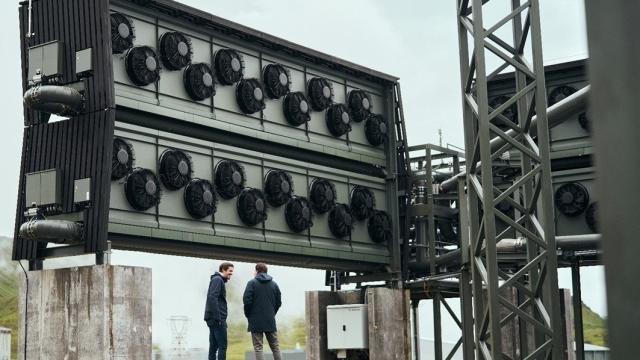The federal government is banking big on the idea of a climate change “undo” button.
On Thursday, the U.S. Department of Energy declared its official intent to fund $US3.5 ($5) billion in carbon dioxide removal via direct air capture. This announcement signals the Biden administration’s aim to pour billions of dollars into developing, building, and maintaining giant machines to suck greenhouse gas out of the sky and permanently store carbon dioxide — which both is and isn’t as crazy at is sounds.
“President Biden’s Bipartisan Infrastructure Law is funding new technologies that will not only make our carbon-free future a reality but will help position the U.S. as a net-zero leader while creating good-paying jobs for a transitioning clean energy workforce,” said U.S. Energy Secretary, Jennifer Granholm in a statement.
The newly confirmed DOE funding was first outlined in the infrastructure bill passed last year, and is part of $US6.5 ($9) billion promised in the law for carbon management. The money will be used to build four direct air capture “hubs” positioned in different regions around the country.
Some amount of carbon capture is necessary if we want to achieve net zero greenhouse gas emissions, and it’s an “essential element” in scenarios that avoid critical thresholds of warming, according to the most recent UN IPCC report. The importance of carbon dioxide removal, the IPCC found, comes largely from its potential role in helping undo some of the damage we’ve already done to the atmosphere while we work to zero out emissions from industries that are tough to decarbonize like cement and steel manufacturing.
Without any carbon dioxide removal — be it growing more trees, soil conservation, direct air capture, or something else — mitigating climate change becomes a whole lot more difficult. And although it’s not clear exactly how much carbon capture we need, estimates are somewhere on the scale of one to ten metric gigatons of CO2 globally per year.
For comparison, the U.S. emitted more than 5.2 gigatons of CO2 in 2021. Each of the newly funded four regional hubs will, in theory, pull a minimum of one million metric tons of carbon dioxide out of the atmosphere every year — a total of less than 1/1000th of our national annual emissions.
Even though it’s a fraction of what we emit, that number is still a pretty ambitious target, given the current state of carbon dioxide removal. Direct air capture is a relatively new technology that’s pretty expensive to sow for the amount of benefit reaped. The proposed U.S. hub development (the exact technology and plans for these facilities don’t exist yet) will eat up almost 10% of Biden’s proposed 2022 budget for climate change, sucking up money 100x more efficiently than greenhouse gases.
The largest existing CDR facility is the Orca direct air capture plant in Iceland, which came online last fall to great fanfare. Despite the hype, the Orca plant currently sequesters just 4,000 metric tons of CO2 — a fraction of what the four U.S. hubs would theoretically pull from the air, and the equivalent of less than the yearly emissions from just 800 cars. And it’s pretty expensive to operate: Orca’s owners are aiming to run the plant at the cost of $US100 ($139) per ton of CO2 removed from the air. While other projects in progress have promised a cheaper return, the technology is still so new that we have no idea if removing CO2 from the air will ever be economically feasible — meaning the proposed U.S. hubs could eat a lot of cash.
To be fair, we’re probably going to have to invest big in the renewable energy transition regardless of how we go about it: one analysis estimates that the U.S. will have to spend $US4.5 ($6) trillion to completely transition the grid to renewable energy. But in the most fairy tail of scenarios: In which $US3.5 ($5) billion of DOE funding actually covers the total cost of researching and building (not to mention running) four direct air capture hubs, that earnestly take up all of the promised CO2, offsetting all U.S. emissions using the technology would still be at least $US50 ($69) billion more expensive than switching to renewables.
The U.S. government has previously gambled on carbon capture projects that didn’t pay off, while emerging issues in the reliability of CO2 transport and storage could have implications for direct air capture hubs. Plus, there’s always the chance that the promise of carbon removal becomes weaponised by industry and big tech as a way to maintain or even increase their emissions.
We need some sort of carbon capture if we’re to avoid the worst consequences of climate change. But direct air capture technology is in its infancy, and it absolutely can’t stand alone without other, bigger climate change mitigation investments like, for instance, a decarbonized energy grid.
We know not burning fossil fuels is a guaranteed way to mitigate climate change. And we know that we need alternate, renewable energy and transportation strategies for the long term. Let’s hope massive carbon vacuums don’t become the focus of our national climate strategy.
